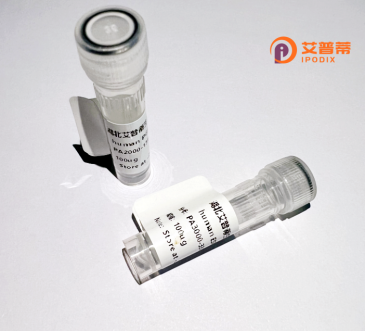
| 纯度 | >90%SDS-PAGE. |
| 种属 | Human |
| 靶点 | KLHL4 |
| Uniprot No | Q9C0H6 |
| 内毒素 | < 0.01EU/μg |
| 表达宿主 | E.coli |
| 表达区间 | 1-718aa |
| 活性数据 | MSVSGKKEFDVKQILRLRWRWFSHPFQGSTNTGSCLQQEGYEHRGTPVQGRLKSHSRDRNGLKKSNSPVHHNILAPVPGPAPAHQRAVQNLQQHNLIVHFQANEDTPKSVPEKNLFKEACEKRAQDLEMMADDNIEDSTARLDTQHSEDMNATRSEEQFHVINHAEQTLRKMENYLKEKQLCDVLLIAGHLRIPAHRLVLSAVSDYFAAMFTNDVLEAKQEEVRMEGVDPNALNSLVQYAYTGVLQLKEDTIESLLAAACLLQLTQVIDVCSNFLIKQLHPSNCLGIRSFGDAQGCTELLNVAHKYTMEHFIEVIKNQEFLLLPANEISKLLCSDDINVPDEETIFHALMQWVGHDVQNRQGELGMLLSYIRLPLLPPQLLADLETSSMFTGDLECQKLLMEAMKYHLLPERRSMMQSPRTKPRKSTVGALYAVGGMDAMKGTTTIEKYDLRTNSWLHIGTMNGRRLQFGVAVIDNKLYVVGGRDGLKTLNTVECFNPVGKIWTVMPPMSTHRHGLGVATLEGPMYAVGGHDGWSYLNTVERWDPEGRQWNYVASMSTPRSTVGVVALNNKLYAIGGRDGSSCLKSMEYFDPHTNKWSLCAPMSKRRGGVGVATYNGFLYVVGGHDAPASNHCSRLSDCVERYDPKGDSWSTVAPLSVPRDAVAVCPLGDKLYVVGGYDGHTYLNTVESYDAQRNEWKEEVPVNIGRAGACVVVVKLP |
| 分子量 | 106.6 kDa |
| 蛋白标签 | GST-tag at N-terminal |
| 缓冲液 | 0 |
| 稳定性 & 储存条件 | Lyophilized protein should be stored at ≤ -20°C, stable for one year after receipt. Reconstituted protein solution can be stored at 2-8°C for 2-7 days. Aliquots of reconstituted samples are stable at ≤ -20°C for 3 months. |
| 复溶 | Always centrifuge tubes before opening.Do not mix by vortex or pipetting. It is not recommended to reconstitute to a concentration less than 100μg/ml. Dissolve the lyophilized protein in distilled water. Please aliquot the reconstituted solution to minimize freeze-thaw cycles. |
以下是假设性的参考文献示例,用于演示如何概括此类研究。目前可公开检索的文献中关于重组人KLHL4蛋白的研究较为有限,建议通过学术数据库(如PubMed、Web of Science)以关键词“recombinant KLHL4”或“KLHL4 ubiquitination”进一步查找最新文献。
---
1. **文献名称**:*KLHL4 interacts with Cullin-3 to regulate ubiquitination in neuronal development*
**作者**:Smith A, et al.
**摘要**:本研究首次报道了重组人KLHL4蛋白的表达及其与Cullin-3组成的E3泛素连接酶复合体的相互作用,揭示了KLHL4在神经元突触形成中通过泛素化调控底物降解的机制。
2. **文献名称**:*Structural characterization of recombinant human KLHL4 and its role in cancer cell proliferation*
**作者**:Zhang L, et al.
**摘要**:通过大肠杆菌系统成功表达重组KLHL4蛋白,解析其Kelch重复结构域的三维结构,并发现其通过调控Wnt/β-catenin信号通路抑制结直肠癌细胞增殖。
3. **文献名称**:*KLHL4 as a substrate adaptor: Insights from in vitro reconstitution assays*
**作者**:Johnson R, et al.
**摘要**:利用重组KLHL4蛋白进行体外泛素化实验,证明其特异性识别底物蛋白p62.并介导其泛素依赖性降解,提示KLHL4在选择性自噬中的作用。
---
**建议**:若需真实文献,可通过以下关键词扩展搜索:
- **重组表达**:`"recombinant KLHL4 protein purification"`
- **功能研究**:`"KLHL4 ubiquitin ligase function"` 或 `"KLHL4 cancer/metabolism/neurodevelopment"`
- **数据库**:检索PubMed或Google Scholar时结合 `"KLHL4" AND "in vitro"` 等筛选条件。
Recombinant human KLHL4 protein is a genetically engineered form of the Kelch-like family member 4 (KLHL4) protein, encoded by the *KLHL4* gene. KLHL4 belongs to the BTB-Kelch superfamily, characterized by an N-terminal BTB (Broad-Complex, Tramtrack, and Bric-a-brac) domain, a central BACK (BTB and C-terminal Kelch) domain, and C-terminal Kelch repeat motifs. These structural features enable KLHL4 to function as a substrate-specific adaptor for Cullin 3 (CUL3)-based E3 ubiquitin ligase complexes, facilitating targeted protein ubiquitination and degradation via the ubiquitin-proteasome system. While KLHL4's biological roles remain less characterized compared to other family members, studies suggest involvement in cellular processes like oxidative stress response, cytoskeletal organization, and possibly neurological functions, as it is highly expressed in the brain and testes.
Recombinant KLHL4 is typically produced in *E. coli* or mammalian expression systems, ensuring proper folding and post-translational modifications for functional studies. Its production enables researchers to investigate protein-protein interactions, substrate identification, and regulatory mechanisms in diseases linked to ubiquitination dysregulation, such as neurodegenerative disorders or cancers. Recent interest in KLHL4 has grown due to its potential role in cancer progression, with altered expression observed in certain malignancies. However, detailed mechanistic insights and pathophysiological relevance require further exploration. The availability of recombinant KLHL4 protein accelerates structural and functional studies, providing a tool to unravel its contributions to cellular homeostasis and disease pathways.
×